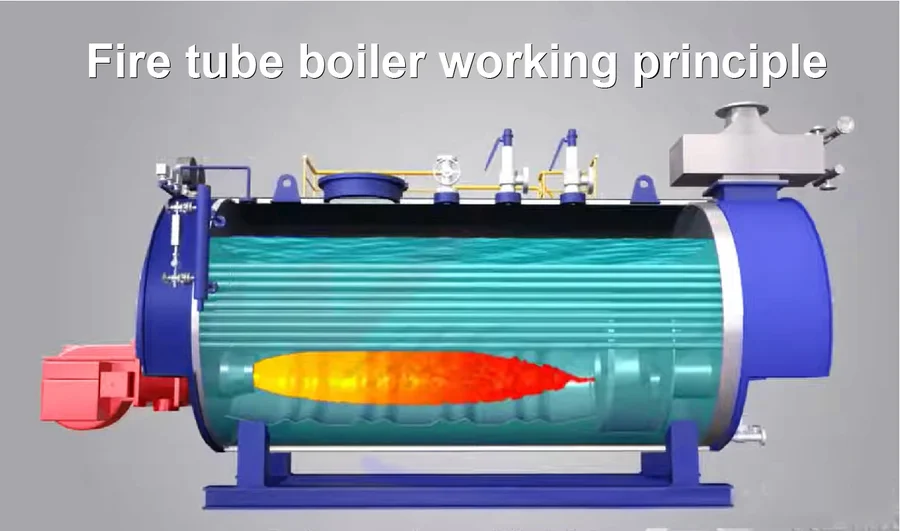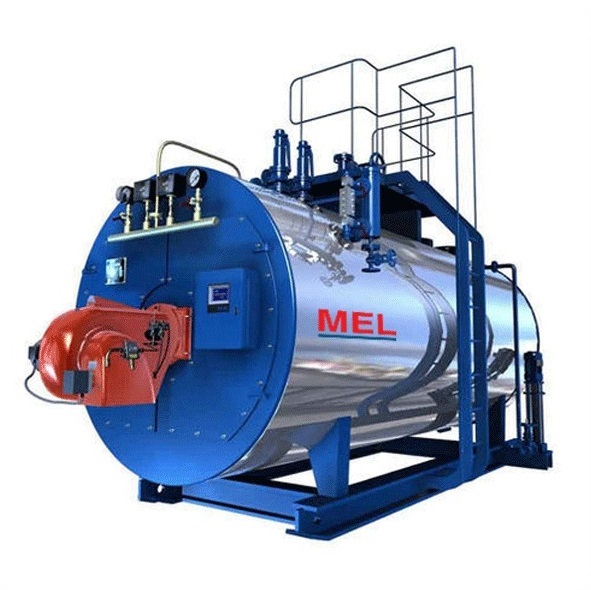Blog
What is Fire Tube Boiler
A fire-tube boiler is a type of boiler where hot gases pass through one or more tubes immersed in water within a sealed container. The heat conducted from the gases it transfers to the surrounding water through thermal conduction, ultimately creating steam. Here are some key points about fire-tube boilers:
Definition:
- A fire-tube boiler has water flowing outside the tubes (surrounding them), while the hot gases produced by the combustion chamber are inside the tubes.
- These boilers are commonly used for generating electricity by rotating turbine blades.
Types of Fire tube Boilers:
There are two main types of fire tube boilers: horizontal and vertical. Horizontal firetube boilers are the most usual and are often seen in homes and businesses. They’re good for places where space is limited. Vertical firetube boilers, on the other hand, are not as common. They’re mostly used in certain industries where they fit better because of their shape.
fire tube boiler working principle
The core operational concept of a fire tube boiler is quite simple. It begins with fuel combustion, where the boiler is fueled typically with coal, wood, or oil. Within the furnace, the fuel undergoes combustion, generating hot gases as a result. These hot gases then flow through the submerged tubes that are situated within the water-filled boiler shell. As the gases pass through the tubes, their heat is transferred to the surrounding water, causing it to boil and ultimately produce steam. In essence, a fire tube boiler operates by allowing hot gases to flow through submerged tubes, transferring their heat to the surrounding water, thus resulting in steam generation. This process forms the core mechanism by which fire tube boilers provide a vital source of heat and power across various industrial applications.
Advantages and disadvantages of fire tube boilers:
Fire tube boilers offer simplicity and cost-effectiveness but come with limitations related to pressure, efficiency, and safety. Engineers and operators must carefully consider these factors when choosing the right boiler type for their specific needs
Let’s delve into the advantages and disadvantages of fire tube boilers:
Advantages of fire tube boilers:
Fire tube boilers offer simplicity, cost-effectiveness, space-efficient and quick steam generation, making them a practical choice for specific scenarios. Explore more advantages of fire tube boiler.
- Compact Design: Fire tube boilers have a simple and compact design, making them space-efficient. They are suitable where space is limited.
- Quick Steam Generation: Fire tube boilers rapidly produce steam due to their straightforward construction. Water circulates through the tubes, and heat from the combustion process generates steam efficiently.
- Easy Maintenance: Their simplicity translates to easy maintenance. Fewer components mean fewer parts to inspect, repair, or replace. This makes fire tube boilers attractive for industries seeking straightforward maintenance procedures.
- Lower Initial Cost: Fire tube boilers generally have a lower upfront cost compared to some other boiler types. This affordability makes them a popular choice for small-scale applications.
disadvantages of fire tube boilers:
When fire tube boilers offer simplicity and cost-effectiveness, they come with some limitations related to pressure, lower efficiency, and handling load fluctuations.
- Fluctuation Handling: Fire tube boilers struggle with load fluctuations, impacting their responsiveness to changing steam demands.
- Limited Capacity: These boilers are not suitable for large-scale industrial operations due to their restricted capacity.
Lower Efficiency: Fire tube boilers exhibit lower overall efficiency compared to water tube boilers. The overall efficiency of fire tube boilers is up to 75% only.
Difference between a fire tube and a water tube boiler
The primary difference between fire tube and water tube boilers lies in their design and construction:fire tube boilers offer simplicity and cost-effectiveness, while water tube boilers excel in efficiency and high-pressure applications.
- Fire Tube Boiler: In a fire tube boiler, hot gases produced by the combustion of fuel flow through the tubes immersed in water within the boiler shell.
- Watertube Boiler: In a water tube boiler, water flows through the tubes while hot gases from combustion surround the tubes.
This fundamental difference in design impacts various aspects of boiler operation, including efficiency, pressure handling capabilities, and suitability for different applications.
Advantages of fire tube boilers over water tube boilers:
Fire tube boilers offer several advantages over water tube boilers in certain applications:
- Compact Design: Fire tube boilers tend to have a simpler and more compact design compared to water tube boilers. This renders them appropriate for installations with space constraints or where a smaller footprint is preferred.
- Lower Initial Cost: Generally, fire tube boilers have a lower initial cost compared to water tube boilers. Their simpler construction and fewer components contribute to reduced manufacturing and installation expenses.
- Quick Steam Generation: Fire tube boilers are capable of generating steam rapidly. The smaller volume of water contained within the tubes allows for quicker heating, making them ideal for applications requiring immediate steam availability.
- Ease of Maintenance: Fire tube boilers are typically easier to inspect and maintain compared to water tube boilers. The straightforward design and accessibility of tubes simplify maintenance tasks, reducing downtime and associated costs.
- Robustness: Fire tube boilers can withstand fluctuations in water quality and steam demand more effectively than water tube boilers. Their simpler design and robust construction make them less susceptible to damage from factors such as water impurities or sudden changes in load.
- Suitability for Low to Medium Pressures: Fire tube boilers are well-suited for applications requiring low to medium steam pressures. They can efficiently generate steam at relatively lower pressures, making them suitable for a wide range of industrial processes and heating applications.
While fire tube boilers offer several advantages in certain scenarios, it’s essential to consider the specific requirements and constraints of each application when selecting the most suitable boiler type. Water tube boilers may still be preferred for applications requiring high steam pressures, larger capacities, or where efficiency is paramount.
Types of Fire Tube Boilers
-
Horizontal Return Tubular Boiler (HRT):
Oldest and simplest type. Features horizontal shell with tubes passing through. Compact and easy to operate, suitable for small-scale industries.
-
Cornish Boiler:
Single large flue containing furnace and combustion chamber. Ideal for heavy industrial applications due to large steam production capacity.
-
Lancashire Boiler:
Two parallel flues increasing heating surface area. Robust and suitable for industries with constant steam demands.
-
Scotch Marine Boiler:
Cylindrical shell with multiple large furnaces. Compact, durable, and easy to maintain.
-
Vertical Fire Tube Boiler:
-
Locomotive Boiler:
- Originally used in steam locomotives, less common in industrial settings today.
Why Choose MEL Group for Boilers?
MEL Group is the first certified boiler manufacturer company in Bangladesh and the only boiler exporter from Bangladesh. At MEL Group, we specialize in industrial boilers. Here’s why we’re the best-
- The most experienced boilermaker since 1983
- Pioneer boiler manufacturer in the country, over 2000 boilers manufactured and now operating in the country.
- Government of Bangladesh Inspection authority certified boiler (as per BBR code).
- High quality boiler; comparable to any other foreign origin.
- Assembled with components imported from USA, UK, EU etc.
- Technical support & regular Maintenance/Service by experienced and skilled service team.
A fire-tube boiler is a type of boiler where hot gases pass through tubes submerged in water, transferring heat to create steam. It’s commonly used in various applications, including locomotives and industrial processes.
The main design features of fire tube boilers are pressure 1–1.6–2.4 MPa, max. 4.0 MPa
An economizer in a boiler is a heat exchanger that captures and utilizes heat from flue gases. It preheats incoming feedwater, reducing fuel consumption and enhancing energy efficiency. 🌡️🔥💧
The most important part of a fire tube boiler is its big round body where water and steam stay. Inside this body, there are small tubes where hot gases from burning stuff flow, heating the water. Then, the smoke goes out through a tall pipe called a chimney.
In a fire-tube boiler, the temperature typically ranges from 1000 to 2000 degrees Fahrenheit (about 540 to 1090 degrees Celsius), depending on various factors such as fuel type and operating conditions.
Types of Fire Tube Boilers
- Cochran Boiler.
- Cornish Boiler.
- Locomotive Boiler.
- Lancashire Boiler.
- Simple Vertical Boiler.
- Scotch Marine Boiler
